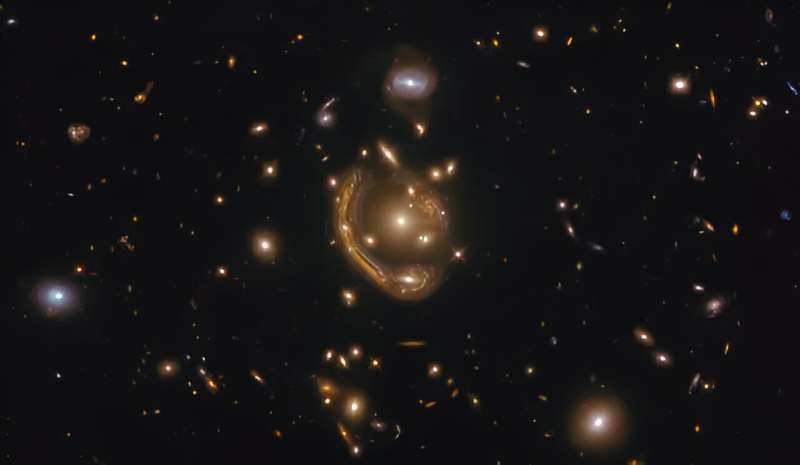This article has been reviewed according to Science X's editorial process and policies. Editors have highlighted the following attributes while ensuring the content's credibility:
fact-checked
peer-reviewed publication
trusted source
proofread
Civilizations could use gravitational lenses to transmit power from star to star

In 1916, famed theoretical physicist Albert Einstein put the finishing touches on his theory of general relativity, a geometric theory for how gravity alters the curvature of spacetime. The revolutionary theory remains foundational to our models of how the universe formed and evolved. One of the many things GR predicted was what is known as gravitational lenses, where objects with massive gravitational fields will distort and magnify light coming from more distant objects. Astronomers have used lenses to conduct deep-field observations and see farther into space.
In recent years, scientists like Claudio Maccone and Slava Turyshev have explored how using our sun as a Solar Gravity Lens (SGL) could have tremendous applications for astronomy and the Search for Extraterrestrial Intelligence (SETI). Two notable examples include studying exoplanets in extreme detail or creating an interstellar communication network (a "galactic internet"). In a recent paper, Turyshev proposes how advanced civilizations could use SGLs to transmit power from star to star—a possibility that could have significant implications in our search for technosignatures.
The preprint of Turyshev's paper, "Gravitational lensing for interstellar power transmission," was recently posted to arXiv and is being reviewed for publication in Physical Review D. Slava G. Turyshev is a research scientist with the Structure of the Universe Research Group at NASA's Jet Propulsion Laboratory. This group is engaged in a wide range of research topics associated with the evolution of the universe from the Big Bang to the present day. This includes the formation of the first stars and galaxies, the role of dark matter and dark energy in the formation of large-scale cosmic structures, and the accelerating expansion of the cosmos universe (respectively).
In previous papers, Turyshev and his colleague, Senior Research Fellow Viktor Toth (Carleton University), have explored the physics of gravitational lenses extensively. They have also explored how a spacecraft located at the focal region of an SGL would allow for cutting-edge astronomy. This includes how an SGL could amplify light from faint distant objects (like exoplanets) to the point where the resolution would be comparable to observations conducted from high orbit. In another paper, SETI astronomer and mathematician Claudio Maccone showed how SGLs could facilitate communication between stars.
In this latest paper, Turyshev explored how a star's gravitational focal point could be used to focus energy and beam it to other star systems. As he indicated in his paper, the same equipment used for interplanetary communications (built to scale) could allow pairs of stellar gravitational lenses to facilitate energy transmission over interstellar distances. This configuration would benefit from the light amplification by both lenses, enabling significant increases in the signal-to-noise ratio (SNR) of the transmitted signal. But as Turyshev told Universe Today via email, a comprehensive analysis of these scenarios has not yet been undertaken:
"This is the topic that I have been trying to stay away from for quite some time, as there were no analytical tools developed to study power transmission. Now, many relevant and important topics are well understood, leading to this work. In this paper, I looked at the feasibility of interstellar power transmission and was able to show that it is possible to achieve a practically relevant Signal-to-noise ratio (SNR), thus showing that one can use the SGLs for that purpose."
For this study, Turyshev used analytical tools from his previous work with SGLs to consider how light can be amplified in multi-lens systems. He then applied these same methods to three free space laser power transmission scenarios that involve lensing with either a single lens or double lenses. In all cases, a point-source transmitter is positioned in the focal region of the lens, which amplifies the power picked up by the receiver. The results indicate that power beaming follows the same principles as light amplification and can be accomplished using similar infrastructure.
Space-based solar power is considered one of the most effective means of providing the planet with clean, renewable energy. This method consists of satellites in low earth orbit (LEO) gathering solar power 24 hours a day and beaming it to receiver stations on Earth using microwave lasers. In this respect, using SGLs to beam power from system to system could extend space-based solar power to interstellar space, facilitating everything from interstellar exploration to interstellar settlement. As Turyshev demonstrated, the mathematics are sound, but there is still much work to be done:
"We show the feasibility and provide the tools that may be used to deal with all these nuances. And we have pretty good SNRs already, so including these extra modeling terms will not significantly reduce the sensitivity. So, this is the first paper that addresses all the topics in a non-speculative manner, focusing only on the physics involved. Many more topics must be addressed—transmitter-lens1-lens2-receiver misalignment, the presence of non-vanishing quadrupole moments characterizing lens' interior structure, etc. But all that is needed now is to deal with each of them."
More information: Slava G. Turyshev, Gravitational lensing for interstellar power transmission, arXiv (2023). DOI: 10.48550/arxiv.2310.17578
Journal information: Physical Review D , arXiv
Provided by Universe Today





















